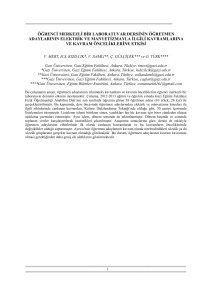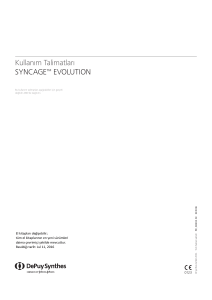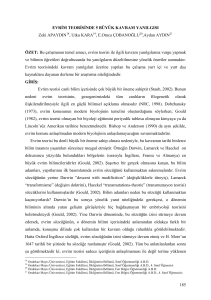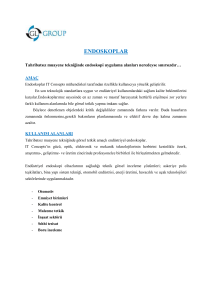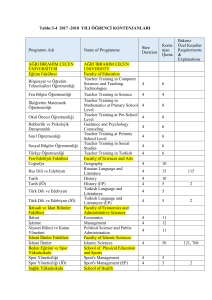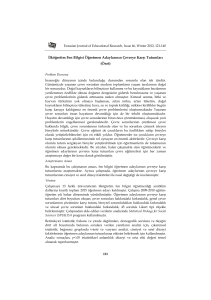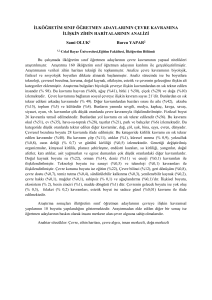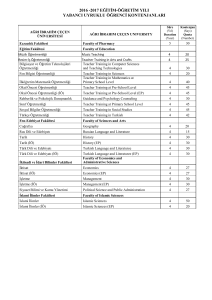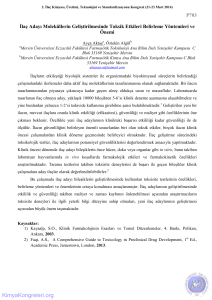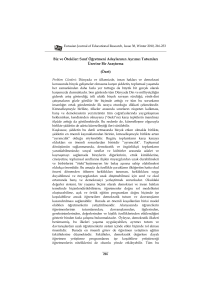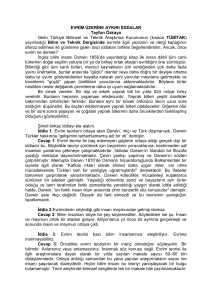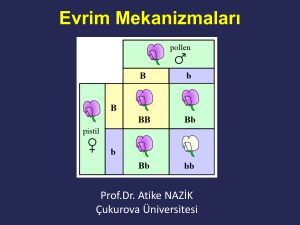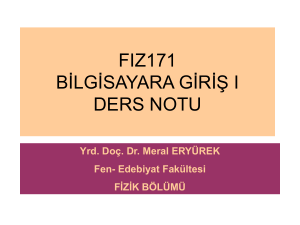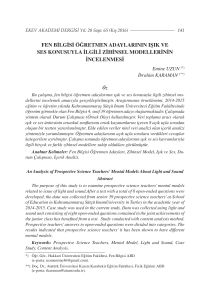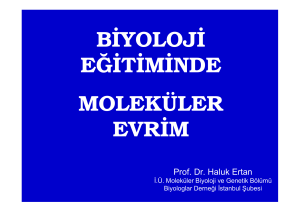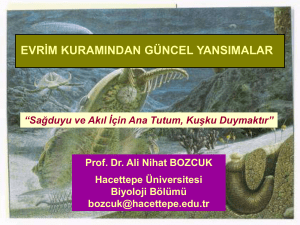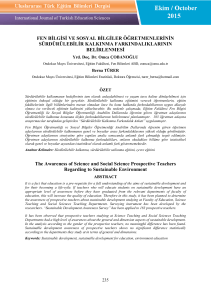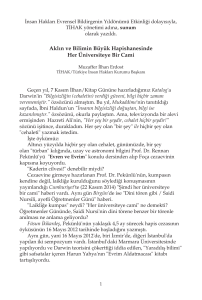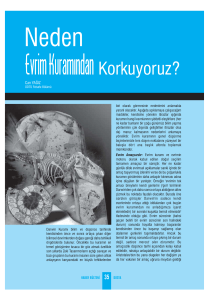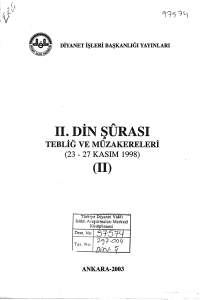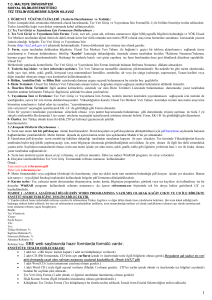Determining The Cognitive Structures of Science - EBAD-JESR
advertisement
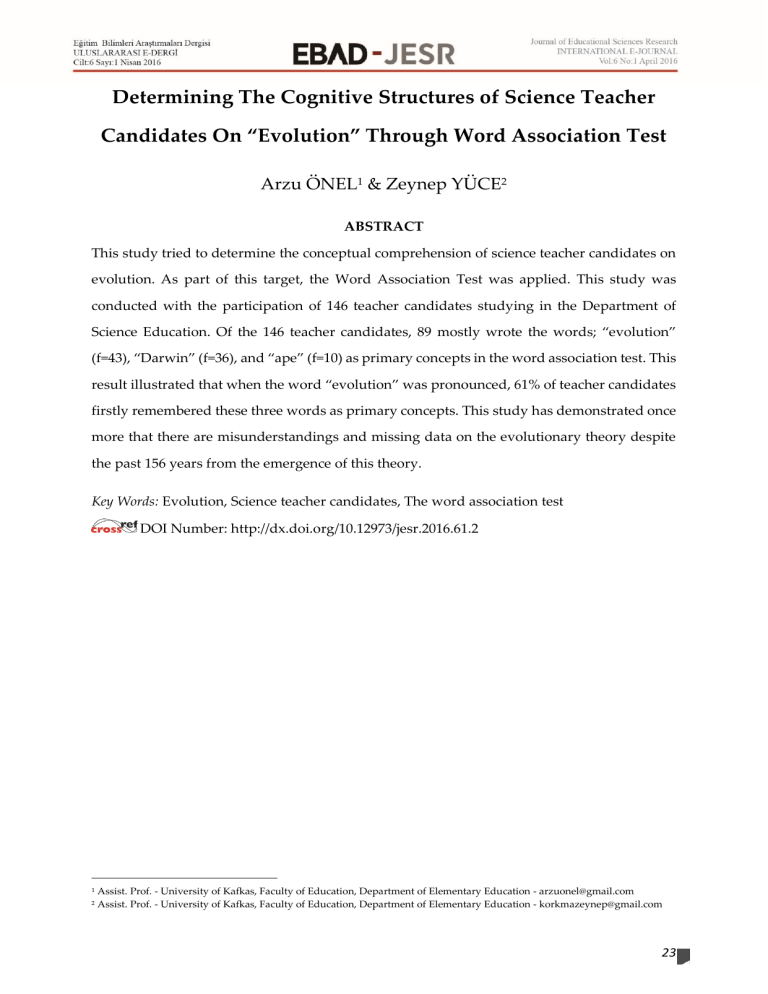
Determining The Cognitive Structures of Science Teacher Candidates On “Evolution” Through Word Association Test Arzu ÖNEL1 & Zeynep YÜCE2 ABSTRACT This study tried to determine the conceptual comprehension of science teacher candidates on evolution. As part of this target, the Word Association Test was applied. This study was conducted with the participation of 146 teacher candidates studying in the Department of Science Education. Of the 146 teacher candidates, 89 mostly wrote the words; “evolution” (f=43), “Darwin” (f=36), and “ape” (f=10) as primary concepts in the word association test. This result illustrated that when the word “evolution” was pronounced, 61% of teacher candidates firstly remembered these three words as primary concepts. This study has demonstrated once more that there are misunderstandings and missing data on the evolutionary theory despite the past 156 years from the emergence of this theory. Key Words: Evolution, Science teacher candidates, The word association test DOI Number: http://dx.doi.org/10.12973/jesr.2016.61.2 1 2 Assist. Prof. - University of Kafkas, Faculty of Education, Department of Elementary Education - arzuonel@gmail.com Assist. Prof. - University of Kafkas, Faculty of Education, Department of Elementary Education - korkmazeynep@gmail.com 23 ÖNEL & YÜCE Determining The Cognitive Structures of Science Teacher Candidates On “Evolution” Through Word Association Test INTRODUCTION The historical past of evolution thinking is as old as human history. As a matter of fact, this historical process is based upon Persian and Egyptian Myths, ancient Greek philosophers like Thales and Aristotle, and the works of Islamic scholars like Cabir bin Hayyan, Nazzam, and Biruni (Çakmak, 2013). However, the theory that is mentioned in the book, Origin of Species, published by the British scientist, Charles Darwin, in 1859 (Demirsoy, 1995) has drawn much attention in many spheres, including those close to Darwin, since first being published, and has remained the focus of discussion for the past 156 years (Pigliucci, 2007; Acar, 2011; Bakırcı & Çalık, 2013). There is a science world on the one hand saying, “What Newton laws mean for physic; periodic table for chemistry; Lincoln for American history; algebra for Maths; movements of citizen rights for social studies programmes; evolution is the same thing for biology” (Özbay, 2011, 40) and on the other hand, there is great resistance against the theory of evolution around the world. That is to say, when some taboo the theory in open defense, others reject it accursedly. This study has been carried out with the thought that there are conceptual problems in the essence of the clash. The given chaos about the issue will not settle unless evolutionary theory is separated from concepts like mutation, recombination, adaptation, selection, isolation, heredity, variation and migration, and these concepts are not that well expressed or comprehended. Evolution theory, as a matter of discussion from the beginning, always attracts rejection and clashes with religion (Pigliucci, 2007), as well as being simply a hard to understand theory for students and society, no matter what the phase of education is. As a matter of fact, Sönmez, Gümüş, & Kurt (2012) relate the thoughts of secondary school students, and similarly, Kozalak & Ateş (2014) on university students from the departments of sciences, that they do not have enough knowledge about the whole evolutionary process; Kahyaoğlu (2013) also states that college students have a lack of attitude towards the education of evolutionary theory. Evolution, as a theory of combining various study fields such as paleontology, biogeography, physiology, ecology, systematic, embryology, genetic, anatomy, molecular biology, and cytology, relates and synthesizes all of these fields (İrez, Çakır, & Doğan, 2007; Yetişir & Kahyaoğlu, 2010). The concepts recalled by such a comprehensive theory will be on a wide perspective, and the related concepts are easier to understand. The National Research Council (1996) reported the concepts emphasizing evolution as a whole: 1. 2. 3. 4. 5. 6. 7. 8. Evolution between species, Speciation, Variety of living beings, Having an ancestor in common, Proof for evolution, Natural selection, Speed and direction of evolution, and Evolution of humankind. However, Çakmak (2013) states: “While discussing a matter, it is important to use the concepts in the proper place. The precondition for evaluating rightly is to discriminate the concepts like macromicro evolutions or evolutionary thinking and evolutionary theory. When the 24 Eğitim Bilimleri Araştırmaları Dergisi – Journal of Educational Sciences Research discrimination is not present, in evolutionary theory, to construct a base becomes impossible and it becomes arguable on a wrong base.”(p. 58) Concepts form the basic essence of cognitive structure and they make the learning process easier by providing them in order to make generalizations related to new situations and interpretation of experiences and human perceptions on the world (Yılmaz & Çolak, 2011). It is significant to assess a well-constructed and intercorrelated knowledge web, rather than independent and disconnected knowledge (MEB, [Ministry of National Education, Turkish Board of Education] 2005). Among the many commonly-known techniques, one is the Word Association Test (WAT) (Işıklı, Taşdere, & Göz, 2011). WAT is an assessment-evaluation technique in determining conceptual change and conceptual misunderstandings, in revealing the relations between concepts in cognitive structures of teacher candidates and students around the many issues of the sciences (Ercan, Taşdere, & Ercan, 2010; Taşdere, Özsevgeç, & Türkmen, 2014). Işıklı et al. (2011) state that WAT is an alternative tool that will often be used in education and that these tests are mostly applied to science education. Güneş, Dilek, Demir, Hoplan, and Çelikoğlu (2010) reveal that the rate in using WAT by science teachers is 27.3%. Although science subjects are attractive, naturally having many abstract concepts as well as technical terms, the lack of grasping the micro-macro wholeness on the level of biological organization of students simply make science subjects harder to be understood conceptually, and therefore to be learned by students. The endeavors of students to comprehend these abstract concepts are limited to generally what they see, hear, and feel in daily life, plus informal education is also substantially far from being scientific. Factors like endeavors to understand the concepts through undeveloped mental skills, learning spaces, belief systems, and the daily lives and experiences of students contradict with the emergence process of scientific knowledge, and the students attribute meaning to scientific knowledge in this process (Köse, 2009; Ercan et al., 2010; Kurt & Ekici, 2013). Besides, science and biology teachers are the ones who teach evolutionary theory. For all these reasons, the views of science teacher candidates about evolutionary theory have been elected to be analyzed in this current study. Word Association Test (WAT), having appropriate usage across different educational areas and being one of the strategies used to evaluate conceptual comprehension, has been applied within this analysis. METHOD Research Model The study has been performed using the survey model and the cognitive level of participants about evolution has been tried to be determined. Participant gender has not been evaluated as a factor, since some studies (Özdemir, 2008; Acar, 2011; Kahyaoğlu, 2013; Yüce & Önel, 2015) state there being no meaningful differentiation between gender factors of participants and their attitudes towards evolutionary theory. Study Group The study has been applied with the participation of 146 teacher candidates, studying in the 1st, 2nd, 3rd and 4th grades at the Department of Science Teaching, Primary Education, at the Faculty of Education of Kafkas University, Turkey, during the fall semester of the 20142015 academic year. 25 ÖNEL & YÜCE Determining The Cognitive Structures of Science Teacher Candidates On “Evolution” Through Word Association Test Data Collection WAT has been applied in order to determine if the relations between the concepts in long-term memory are sufficient or not; to dissect the cognitive structure of science teacher candidates about “evolution” and knowledge web; that is to say, the bounds among the concepts in this structure. Word Association is a technique applied to determine whether or not people construct a relationship between concepts. One or a few key concepts are given in this technique and participants are asked to write the words that they immediately associate with the key concepts (Atasoy, 2004). The given technique can be applied in a few different forms. Bahar, Jonstone, and Sutcliffe (1999), Bahar andÖzatlı (2003), Kazancı, Doğan Bora, and Katırcıoğlu (2005) have studied multiple key concepts, whilst Dikmenli (2010) studied the unique key concept. They all have done so in order to determine the levels of student comprehension of the issues through word association tests. In this current study, the concept “evolution”, a key term, has been repeated five times one under the other, and teacher candidates are asked to write the first five words coming to mind about evolution in one minute. Evolution:……………………….… Evolution:……………………….… Evolution:…………………………. Evolution:…………………………. Evolution:…………………………. The reason why the key concept is written five times is that while writing the associated words with evolution one under the other, the participants are prevented from using the term “Evolution”. If they go through the key concept again after having written a word, they are effectively forced to write another associated concept instead of the key concept. Since this would negate the aims of the study, this has been prevented by repeating the word “evolution” as a concept five times. WAT has three idiosyncrasies; these are the varied answers to a single key concept, the nature of these answers, and the different and similar peculiarities of answers to a key concept. These three peculiarities can be converted into scoring (Atasoy, 2004). Data Analysis In this current study, the data from WAT have been analyzed qualitatively, and the results given descriptively. In this sense, the number of answers to key concept and the variety of these answers have been evaluated and classified. The words written by teacher candidates have been categorized as “concepts about evolution”, the frequency of concepts in each category and their conceptual relations have been counted as a feature. Words unrelated to evolution and those concepts not repeated at least twice have not been evaluated. There are 146 teacher candidates that took part in the study and each of them was asked to write five different words about evolution. In total, 730 answers have been obtained from the participants. All answers have been analyzed and the words they associate with evolution 26 Eğitim Bilimleri Araştırmaları Dergisi – Journal of Educational Sciences Research have been described within ten main concept categories, and forty-five concept sub-categories, as agreed by the two researchers. 502 of the answers are associated with evolution, with 228 answers not associated with evolution or are answers not repeated at least twice. In this respect, 69% of the answers given by the teacher candidates are associated with evolution, whilst 31% are not and have not been assessed. FINDINGS A total of ten main categories and forty-five concept sub-categories were found to be associated with evolution as a result of the data analysis. The frequency and percentage distributions of concepts in each category are listed in Table 1. Table 1. Percentage distributions and frequencies of concepts with evolution Metamorpho sis Evolution of human being Scientists Formation Variation Time Process Innovation Origin Transfer from water to earth Fossil Order Ape Human Human ancestor Darwin Lamarck Existence 43 25 17 1 2 1 - 3 3 - 1 - 1 - Subcategory Total percentag e 14.5% 1.5% 1.2% 1.1% 1.0% Total frequency Total percentag e 5. Word 4. Word 3. Word Frequencies of Sub-categories 2.. Word Subcategories 1.Word Categories Subcategory Total frequency 10 11 5 - 3 3 2 3 - - 2 2 4 - 106 11 9 8 7 1 1 2 5 0.7% - - 2 2 0.6% 0.4% 7.5% 4.0% - - 1 1 1 10 24 7 10 4 5 3 11 4 6 4 3 55 29 - - 1 1 - 2 0.3% 36 10 7 5 3 1 - 1 - - 4 1 3 8 1 61 2 17 8.4% 0.3% 2.3% Cosmic Formation of the world 3 2 2 3 1 11 1.5% 3 3 1 2 2 11 1.5% Big-Bang 1 1 5 1 - 8 1.1% Formation of the planet 1 - 1 1 - 3 0.4% 153 21.0% 86 11.8% 63 8.7% 50 6.9% 27 ÖNEL & YÜCE Determining The Cognitive Structures of Science Teacher Candidates On “Evolution” Through Word Association Test Table 1 - Continuation Disciplines Scientific Theory of Genesis - 8 3 4 - 3 2 1 3 3 15 12 2.1% 1.6% - 2 1 1 - 4 0.6% - 1 1 1 1 4 0.6% - 1 1 1 - - 1 1 1 - - - - 2 1 3 3 3 0.4% 0.4% 0.4% 3 3 5 1 2 14 1.9% 1 2 2 - 1 - 2 1 1 - 6 4 0.8% 0.6% - 1 1 1 - 3 0.4% - - 2 1 - - - 1 3 4 1 - 2 1 1 3 8 5 0.4% 1.1% 0.7% - 2 - - 2 4 0.6% - 1 1 2 - - 1 - 1 - - - - - 2 0.6% 0.3% 0.3% 0.3% 1.2% 0.8% 0.3% 1.1% 0.7% 0.6% 1.4% 0.7% - - - - 2 1 2 4 1 1 2 2 - 2 - - - 2 - - 1 - 2 2 3 1 1 - 3 - 1 1 1 - 1 3 2 1 1 3 4 2 2 2 9 6 2 8 5 4 10 2 - 1 1 1 5 Number of answers associated with evolution Number of answers not associated with evolution Total number of answers given Total frequency Total percentag e 5. Word 4. Word Value judgment 3. Word Vitality 2.. Word Speciation Mutation Adaptation Modificatio n Natural selection Gene Variety Species Living Beings Plants Animal Phylogenesi s Dinosaurs Nonsense Faith Freedom of thought Religion Atheism Islam Sin Genetic Hereditary Biology Science Curiosity Theory Genesis Existence of Allah/God Frequencies of Sub-categories Subcategory Total percentag e 1.Word Categories Subcategories Subcategory Total frequency 44 6.0% 30 4.1% 27 3.7% 17 2.3% 17 2.3% 15 2.1% 502 228 730 69.0% 31.0% 100.0% 28 Eğitim Bilimleri Araştırmaları Dergisi – Journal of Educational Sciences Research The participants associated 502 concepts with evolution. According to these results, the dominant (first) category about evolution has been metamorphosis (f=153). The participants have concentrated on variation, time, process, innovation, origin, transfer from water to earth, fossil and order concepts in this category. The most repeated concept by the participants in this category is variation concept (f=106). This result illustrates that teacher candidates have directly associated the variation concept with evolution. The second category demonstrates that teacher candidates have associated evolution of human beings (f=86) with evolution. They have focused on especially ape (f=55) and human (f=29) concepts in this category. These results display that teacher candidates relate apes and humans directly with evolution. The third category shows that teacher candidates have related Darwin (f=61) and Lamarck (f=2) with evolution. When looking over the frequency of this category, teacher candidates have most associated Darwin directly with evolution. The fourth category shows that they have associated formation (f=50) with evolution. In this category, participants have dealt with existence, cosmic, formation of world, big-bang and formation of planet concepts. The most repeated and directly associated first three concepts given by the participants were existence (f=17), cosmic (f=11) and formation of world (f=11). In the fifth category, the candidates have associated speciation (f=44) with evolution. In this category, participants have dealt with mutation, adaptation, modification, natural selection, gene, variety and species concepts. The most repeated are mutation (f=15) and adaptation (f=12). The sixth category shows that candidates have related vitality (f=30) with evolution. In this category, participants have focused on living beings (f=14), plant (f=6), animal (f=4), Phylogenesis (f=3) and dinosaur (f=3) concepts. The seventh category illustrates that candidates have associated value judgments (f=27) with evolution. In this category, participants have focused on nonsense (f=8), faith (f=5), freedom of thought (f=4), religion (f=4), atheism (f=2), Islam (f=2), and sin (f=2) as concepts. The eighth category is based on candidates have associated science (f=17) with evolution. In this category, participants have focused on genetic (f=9), hereditary (f=6) and biology (f=2) concepts and they have directly related these sciences with evolution. The ninth category demonstrates that teacher candidates have associated being scientific (f=17) with evolution. In this category, participants have directly related science (f=8), curiosity (f=5) and theory (f=4) concepts with evolution. The tenth category indicates that teacher candidates have related the genesis concept (f=15) with evolution. In this category, participants have focused on genesis (f=10) and the existence of Allah/God (f=5) and they have directly associated evolution with the existence of Allah/God. 89 of the 146 participant teacher candidates have written variation (f=43), Darwin (f=36) and ape (f=10) concepts as a first word in the word association test. This result indicates that 61% of teacher candidates have recalled these three terms firstly when they have heard “evolution”. 29 ÖNEL & YÜCE Determining The Cognitive Structures of Science Teacher Candidates On “Evolution” Through Word Association Test DISCUSSION, CONCLUSION, AND RECOMMENDATIONS In this study, 31% of science teacher candidates have incorrect perceptions and a lack of knowledge about evolution, having associated evolution with unrelated words. Meanwhile, nearly half of the words associated with evolution are variation (21%), Darwin (12%), ape (11%) and human (6%), which displays surface comprehension of evolutionary theory by the science teacher candidates. In the Turkish study by Kozalak and Ateş (2014), the acceptance levels of students in science teaching about evolution was researched and the teacher candidates stated that they were mostly indecisive, indicating that they graduated from high school with insufficient knowledge about the issue. Nearly 25 years ago, Bloom (1989) revealed that participants had significant concept mistakes and beliefs about scientific theories in the his study that researched the thoughts of science teacher candidates about science, theories and evolution. Bloom indicated how these mistakes and beliefs affected the comprehension of participants in science, their approaches to evolutionary theory and their plans to teach this theory. Incorrect perceptions and beliefs related to evolutionary theory have been researched around the world. For example, Williams (2009) illustrated that only 54% of people in England (Darwin’s home) knew that Charles Darwin even wrote a book called Origin of Species. This result indicates that Darwin has not been understood even in his own country. Besides, Graf & Soran (2011) illustrate that in a study focused on the knowledge of evolution and beliefs of biology teacher candidates studying at two universities in Germany and Turkey, evolution was not accepted as expected by future teacher candidates, especially the Turkish students were not convinced about of evolution. Most participants have difficulties in understanding the evolutionary mechanism (Cited in: Acar, 2011). According to the results of the international study by Miller, Scott & Okamoto in 2006, Turkey was found to be ranked bottom among 34 countries with only 25% adopting evolution. In the same study, USA was second to last, just above Turkey. In this study, the rate 69% of answers correctly relating to evolution shows that students have improved on evolution issues throughout their college education, yet, they have not associated evolutionary theory with concepts like mutation, recombination, adaptation, isolation, hereditary, variation and migration. Özbay (2011), in his study, reveals that the rate in the answers of secondary students to evolutionary theory and basic mechanisms of evolution have been so low. Findley, Lindsey & Watts (2001) state that there is a relation between evolutionary theory and religious belief and this relation prevents learning about evolution. Köse (2010) demonstrates that most participants in the study reject evolution and the reason for that is related to the religious beliefs of students, the attitudes of teachers towards evolution and shortcomings in the teaching of evolutionary theory at schools. Similarly, Acar (2011) also states that teachers are indecisive against evolutionary theory. This situation arises in this current study, yet, only 27 value judgments and 15 theory of genesis answers, out of 502 in total from 146 participants, were related to evolution. However, at least 17 answers associated with being scientific shows that manner is about to change, science teacher candidates are able to discriminate religion and science relatively. Şimşek and Tezcan (2008) reveal that the factors like abstract degree, complexity, similarity/difference with daily language in the development of thoughts about science concepts have been effective. They state that a concept is perceived less abstract, with children generating less alternative thoughts about it when it has less experience. When the associated 30 Eğitim Bilimleri Araştırmaları Dergisi – Journal of Educational Sciences Research concepts with evolutionary theory are considered as abstract, the stated difficulty emerges; which is shown with high rates in this current study. When looked at the words associated with evolution by science teacher candidates, variation, Darwin, ape and human were the most repeated words. As having an important place in the evolutionary issue; comparatively, concepts like mutation, adaptation, modification, natural selection, gene, species and origin have been revealed by teacher candidates much less. For the evolution issue, in creating concept, obtaining and developing, this can be seen as an indicator of difficulty in grasping these less abstract concepts. In most recent field studies (Özdemir, 2008; Apaydın & Sürmeli, 2009; Annaç & Bahçekapılı, 2012), it has been remarked that evolutionary theory has not been widely accepted in Turkey. The rate of acceptance of evolutionary theory has been shown to be very low and these problems stem from lack of knowledge related to evolutionary theory. Besides, Yüce and Önel (2015) state that while nearly 89% of participants accepted gene theory, 84% for atom theory, 80% for cell theory, and 61% for germ theory as scientific in a study that researched the levels of science teacher candidates comprehending and accepting many scientific theories, the levels of candidate comprehension and acceptance of evolutionary theory were just 54%. The association of evolutionary theory with the theory of genesis rather than religion; having lots of abstract concepts; its perception as human evolution mostly as interpretation of humans descending from apes; the formation of our planet and universe physically and chemically; its non-related condition with non-living evolutionary process causes all the problems given. It will make concepts related to formation mechanisms more easier to be understood for students from primary to higher education by addressing these problems. REFERENCES Acar, A. (2011). Biyoloji öğretmenlerinin evrim teorisi ile ilgili görüşleri. (Unpublished Master’s Thesis). Selçuk Üniversitesi Eğitim Bilimleri Enstitüsü, Konya. Annaç, E., & Bahçekapılı, H. G. (2012). Understanding and acceptance of evolutionary theory among Turkish university students. Doguş Üniversitesi Dergisi, 13(1), 1-11. Apaydın, Z., & Sürmeli, H. (2009). Üniversite öğrencilerinin evrime yönelik tutumları. ilköğretim online, 8(3), 820-842. Retrieved from http://ilkogretim-online.org.tr. Atasoy, B. (2004). Fen öğrenimi ve öğretimi (2nd ed.). Ankara: Asil Yayın Dağıtım Ltd. Şti. Bahar, M., Jonstone, A. H., & Sutcliffe, R. G. (1999). Investigation of students’ cognitive structure in elementary genetics through word association tests. Journal of Biological Education, 33(3), 134-141. Bahar, M., & Özatlı, N. S. (2003). Kelime iletişim test yöntemi ile lise 1. sınıf öğrencilerinin canlıların temel bileşenleri konusundaki bilişsel yapılarının araştırılması. Balıkesir Üniversitesi, Fen Bilimleri Enstitüsü Dergisi, 5(1), 75-85. Bakırcı, H., & Çalık, M. (2013). Adaptasyon ve doğal seçilim konusunda geliştirilen rehber materyallerin sekizinci sınıf öğrencilerinin alternatif kavramlarının giderilmesine etkisi. Eğitim ve Bilim, 38(168), 215-229. Bloom, J. W. (1989). Preservice elementary teachers' conceptions of science: science, theories and evolution. International Journal of Science Education, 11(4), 401-415. Çakmak, M. (2013). Evrim teorisi tanrının varlığı için bir tehdit midir? Uludağ Üniversitesi İlahiyat Fakültesi Dergisi, 22(2), 55-81. Demirsoy, A. (1995). Kalıtım ve evrim. Ankara: Meteksan Matbaacılık. 31 ÖNEL & YÜCE Determining The Cognitive Structures of Science Teacher Candidates On “Evolution” Through Word Association Test Dikmenli, M. (2010). Biology student teachers' conceptual frameworks regarding biodiversity. Education, 130(3), 479-489. Ercan, F., Taşdere, A., & Ercan, N. (2010). Kelime ilişkilendirme testi aracılığıyla bilişsel yapının ve kavramsal değişimin gözlenmesi. Türk Fen Eğitimi Dergisi, 7(2), 136-154. Findley, A. M., Lindsey, S. J., & Watts, S. (2001). the impact of religious on learning in the science classroom. Annual Meeting of the Mid-South Educational Research Association, 1-15. Retrieved from http://files.eric.ed.gov/fulltext/ED460017.pdf Güneş, T., Dilek, N. Ş., Demir, E. S., Hoplan, M., & Çelikoğlu, M. (2010). Öğretmenlerin kavram öğretimi, kavram yanılgılarını saptama ve giderme çalışmaları üzerine nitel bir araştırma. International Conference on New Trends in Education and Their Implications, 1113 November, Antalya. İrez, S., Çakır, M., & Doğan, Ö. (2007). Bilimin doğasını anlamak: evrim eğitiminde bir önkoşul. Biyoloji Eğitiminde Evrim Konferansı. İnönü Üniversitesi, Malatya, Türkiye. Işıklı, M., Taşdere, A., & Göz, N. L. (2011). Kelime ilişkilendirme testi aracılığıyla öğretmen adaylarının Atatürk ilkelerine yönelik bilişsel yapılarının incelenmesi. Uşak Üniversitesi Sosyal Bilimler Dergisi, 4(1), 50-72. Kahyaoğlu, M. (2013). The teacher candidates’ attitudes towards teaching of evolution theory. Necatibey Eğitim Fakültesi Elektronik Fen ve Matematik Eğitimi Dergisi, 7(1), 83-96. Kazancı, M., Doğan Bora, N., & Katırcıoğlu, H. (2005). Investigation of meaningful level of meiosis within students by word association test. Eurasian Journal of Educational Research, 21, 146-154. Köse, E. Ö. (2009). Biyoloji 9 ders kitabında hücre ile ilgili metinlerin okunabilirlik düzeyleri. Journal of Arts and Sciences, 12, 141-150. Köse, E. Ö. (2010). Biyoloji öğretmenlerinin ve öğrencilerinin dini inanışları ve evrim teorisine karşı tutumları. Hacettepe Üniversitesi Eğitim Fakültesi Dergisi, 38, 189-200. Kozalak, G., & Ateş, A. (2014). Üniversite fen bilimleri birinci sınıf öğrencilerinin evrim teorisini kabul düzeyleri. Asya Öğretim Dergisi, 2(1-Özel), 135-148. Kurt, H., & Ekici, G. (2013). Biyoloji öğretmen adaylarının bağımsız kelime ilişkilendirme testi ve çizme-yazma tekniğiyle “osmoz” kavramı konusundaki bilişsel yapılarının belirlenmesi. Turkish Studies - International Periodical for the Languages, Literature and History of Turkish or Turkic, 8(12), 809-829. MEB (Milli Eğitim Bakanlığı Talim ve Terbiye Kurulu Başkanlığı) (2005). İlköğretim Fen ve Teknoloji Dersi Öğretim Programı ve Kılavuzu 6., 7. ve 8. Sınıflar. Ankara: Devlet Kitapları Müdürlüğü. Miller, J. D., Scott, E. C. & Okamoto, S. (2006). Science communication: Public acceptance of evolution. Science, 313, 765-766. National Research Council (1996). National science education standards. Washington, DC: National Academy Press. Özbay, H. E. (2011). Ortaöğretim öğrencilerinin bilimsel okuryazarlık seviyeleri ile evrimi anlamaları arasındaki ilişki (Malatya İli Örneği). (Unpublished Master’s Thesis). İnönü Üniversitesi, Eğitim Bilimleri Enstitüsü. Özdemir, O. (2008). Biyoloji öğretmen adaylarının evrim teorisini benimseme ve anlama güçlüklerinin incelenmesi. Çağdaş Eğitim Dergisi, 33(354), 19-27. Pigliucci, M. (2007). The evolution-creation wars: Why teaching more science just is not enough. McGill Journal of Education, 42(2), 285-306. Sönmez, S., Gümüş, İ., & Kurt, M. (2012). Türk eğitim sisteminde evrim. Ekev Akademi Dergisi, 16(51), 229-246. 32 Eğitim Bilimleri Araştırmaları Dergisi – Journal of Educational Sciences Research Şimşek, C. L., & Tezcan, R. (2008). Factor influence the development of children’s ideas about science concepts. Elementary Education Online, 7(3), 569-577. Taşdere, A., Özsevgeç, T., & Türkmen, L. (2014). Bilimin doğasına yönelik tamamlayıcı bir ölçme aracı: Kelime ilişkilendirme testi. Fen Eğitimi ve Araştırmaları Derneği, Fen Bilimleri Öğretimi Dergisi, 2(2), 129-144. Williams, J. D. (2009). Belief versus acceptance: Why do people not believe in evolution. Science & Society, 31(11), 1255-1262. Yetişir, M. İ., & Kahyaoğlu, M. (2010). Pre-service teacher’ attitudes toward teaching of evolution theory. Procedia Social and Behavioral Science, 2, 1720-1724. Yılmaz, K., & Çolak, R. (2011). Kavramlara genel bir bakış: kavramların ve kavram haritalarının pedagojik açıdan incelenmesi/a look at concepts: Investigation of concepts and concept maps from pedagogical perspective. Atatürk Üniversitesi Sosyal Bilimler Enstitüsü Dergisi, 15(1), 185-204. Yüce, Z., & Önel, A. (2015). Fen öğretmen adaylarının bilimin doğasını anlamaları ve evrim teorisini kabul düzeylerinin belirlenmesi. Turkish Studies, 10(15), 857-872. 33 ÖNEL & YÜCE Determining The Cognitive Structures of Science Teacher Candidates On “Evolution” Through Word Association Test Fen Bilgisi Öğretmen Adaylarının “Evrim” Konusundaki Bilişsel Yapılarının Kelime İlişkilendirme Testi ile Belirlenmesi Arzu ÖNEL3 & Zeynep YÜCE4 Giriş İngiliz Charles Darwin’in 1859 yılında yayınlanan ve yayınlandığı andan itibaren başta Darwin’in yakın çevresi olmak üzere hemen herkesin büyük tepkisini çeken Türlerin Kökeni adlı kitapta yer alan teori, geçen 156 yıla rağmen tartışılmaya devam etmektedir (Pigliucci, 2007; Acar, 2011; Bakırcı & Çalık, 2013). Bir yanda “Fizik için Newton yasaları; Kimya için periyodik tablosu; Amerikan tarihi için Lincoln; Matematik için cebir; Sosyal çalışma programları için vatandaşlık hakları akımları ne ise biyoloji için de evrim kuramı aynı şeydir” (Özbay, 2011, 40) diyen bilim dünyası var iken diğer yanda, dünya genelinde evrim teorisine direnç gösteren büyük bir kesim bulunmaktadır. Yani teori dünya genelinde bazı kesimlerce tabulaştırılıp resmen savunulurken bazı kesimlerce de lanetlenmişçesine reddedilmektedir. Bu çelişkinin kökeninde kavramsal sorunlar olduğu düşüncesiyle bu çalışma yapılmıştır. Evrim teorisi, mutasyon, rekombinasyon, adaptasyon, seleksiyon, izolasyon, kalıtım, varyasyon ve göç gibi kavramlarla bütünleştirilmediği ve bu kavramlar tam olarak anlatılmadığı ve anlaşılmadığı sürece de konu ile ilgili söz konusu kaos bitmeyecektir. Ortaya atıldığı ilk günden beri tartışma konusu olan, sürekli reddiyeler alan ve din ile çarpıştırılan evrim teorisinin (Pigliucci, 2007), eğitimin hangi kademesinde olursa olsun öğrenciler ve toplum tarafından doğru anlaşılması da hep zor olmuştur. Nitekim Sönmez, Gümüş ve Kurt (2012) ortaöğretim öğrencilerinin, Kozalak ve Ateş (2014) ise üniversite fen bilimleri bölümlerinde okuyan öğrencilerin evrimsel süreç ile ilgili yeterli bilgiye sahip olmadıklarını; Kahyaoğlu (2013) da üniversite öğrencilerinin evrim teorisi öğretimine yönelik tutumlarının düşük olduğunu bildirmişlerdir. Paleontoloji, biyocoğrafya, fizyoloji, ekoloji, sistematik, embriyoloji, genetik, anatomi, moleküler biyoloji ve sitoloji gibi çok farklı çalışma alanlarını birleştirici bir teori olarak evrim, tüm bu alanları sentezler ve birbirleri ile ilişkilendirir (Akt: İrez, Çakır & Doğan, 2007; Yetişir & Kahyaoğlu, 2010). Böylesine kapsamlı bir teorinin çağrıştırdığı kavramlar da çok geniş bir perspektifte olacak, doğru ve ilintili kavramları çağrıştırması ise ancak konunun doğru anlaşılması ile mümkün olacaktır. Evrimi bir bütün olarak vurgulayan kavramları National Research Council (1996), (1) türler zaman içinde evrimleşir, (2) türleşme, (3) canlıların çeşitliliği, (4) ortak bir ataya sahip olma, (5) evrime deliller, (6) doğal seçilim, (7) evrimin hızı ve yönü, (8) insanın evrimi olarak bildirmiştir. Eğitimde, birbirlerinden bağımsız ve kopuk olan bilgileri değerlendirmek yerine, birbiri ile bağlı, iyi yapılandırılmış bir bilgi ağını değerlendirmek önemlidir (MEB, 2005). Bu amaca hizmet eden tekniklerden birisi de kelime ilişkilendirme testi (KİT)’dir (Işıklı, Taşdere & Göz, 2011). KİT, fen bilimleri alanında birçok konuda öğrencilerin ve öğretmen adaylarının bilişsel yapılarındaki kavramlar arasındaki ilişkileri ortaya koymada, kavram yanılgılarını 3 4 Yrd. Doç. Dr. - Kafkas Üniversitesi Eğitim Fakültesi İlköğretim Bölümü - arzuonel@gmail.com Yrd. Doç. Dr. - Kafkas Üniversitesi Eğitim Fakültesi İlköğretim Bölümü - korkmazeynep@gmail.com 34 Eğitim Bilimleri Araştırmaları Dergisi – Journal of Educational Sciences Research belirlemede ve kavramsal değişimi tespit etmede kullanılan bir ölçme-değerlendirme tekniğidir (Ercan, Taşdere & Ercan, 2010; Taşdere, Özsevgeç & Türkmen, 2014). Öğrencilerin günlük yaşamları ve deneyimleri, inanç sistemleri, öğrenme ortamları, gelişmemiş zihinsel becerileriyle kavramları anlamlandırma çabaları gibi etkenler bilimin doğasıyla ve bilimsel bilginin ortaya çıkış süreciyle çelişmekte ve öğrenciler bu süreçte bilimsel bilgiye yanlış anlamlar yüklemektedirler (Köse, 2009; Ercan, Taşdere & Ercan, 2010; Kurt & Ekici, 2013). Ayrıca evrim teorisini öğreten ve öğretecek olan biyoloji öğretmenleri ile fen bilgisi öğretmenleridir. Tüm bu sebeplerle, fen bilgisi öğretmen adaylarının evrim teorisi hakkındaki düşünceleri bu çalışma ile belirlenmeye çalışılmış, bu amaçla kavramsal anlamayı ölçen stratejilerden olan ve farklı eğitim ortamlarında kullanılabilme esnekliğine sahip kelime ilişkilendirme testi (KİT) kullanılmıştır. Yöntem Çalışma, 2014–2015 eğitim-öğretim yılı güz döneminde Kafkas Üniversitesi Eğitim Fakültesi İlköğretim Bölümü Fen Bilgisi Öğretmenliği Anabilim Dalı’nın 1, 2, 3. ve 4. sınıflarında öğrenim gören toplam 146 öğretmen adayının katılımıyla tarama modelinde yürütülmüş ve katılımcıların evrim konusunda sahip oldukları bilişsel düzey belirlenmeye çalışılmıştır. Fen bilgisi öğretmen adaylarının “Evrim” kavramı ile ilgili bilişsel yapısını ve bu yapıdaki kavramlar arası bağları yani bilgi ağını çözümlemek, uzun dönemli hafızalarında bulunan kavramlar arasındaki ilişkilerin yeterli olup olmadığını tespit etmek amacıyla KİT veri toplama aracı olarak kullanılmıştır. Kelime ilişkilendirme, insanların kavramlar arasında ilişki kurup kurmadığını belirlemek için düzenlenmiş bir tekniktir. Kelime ilişkilendirmede bir ya da bir kaç anahtar kavram verilir ve kısa bir sürede insanların anahtar kavram ile ilgili ilişki kurdukları kelimeleri yazması istenir (Atasoy, 2004). Bu çalışmada, anahtar kavram olarak yer alan “evrim” kavramı alt alta beş kez tekrarlanmıştır ve öğretmen adaylarının evrim ile ilgili akıllarına gelen ilk beş kelimeyi bir dakika içinde yazmaları istenmiştir. Evrim:………………………………… Evrim:………………………………… Evrim:………………………………… Evrim:………………………………… Evrim:………………………………… Anahtar kavramın beş kez yazılmasının nedeni, katılımcıların evrim ile ilişkilendirdikleri kelimeleri alt alta yazarken “Evrim” kavramından uzaklaşma riskinin önlenmesidir. Katılımcılar bir kelime yazdıktan sonra tekrar anahtar kavram doğrultusunda gitmezlerse, anahtar kavramın yerine yazdıkları önceki kelimelerle ilişkili kavramları yazmak zorunda kalacaklardır. Bu durum, testin amacına ters düşeceğinden evrim kavramı beş kez tekrar edilerek bu durum engellenmeye çalışılmıştır. 35 ÖNEL & YÜCE Determining The Cognitive Structures of Science Teacher Candidates On “Evolution” Through Word Association Test Çalışmada KİT’den elde edilen veriler nitel olarak analiz edilmiştir. Analiz neticesinde çıkan sonuçlar betimsel olarak verilmiştir. Bu doğrultuda, anahtar kavrama verilen cevapların sayısı ve bu cevapların çeşidi değerlendirmeye alınmış ve sınıflandırılmıştır. Öğretmen adaylarının yazdıkları kelimeler “evrim ile ilgili kavramlar” şeklinde kategorize edilmiş, her kategorideki kavramların sıklıkları ve anlamsal ilişkileri bir belirleyici olarak hesaplanmıştır. Evrim ile ilişkili olmayan kelimeler ve en az iki kere tekrar edilmeyen kavramlar değerlendirmeye alınmamıştır. Katılımcılardan toplamda 730 yanıt elde edilmiştir. Bütün yanıtlar incelenmiş ve katılımcıların evrim ile ilgili ilişki kurdukları kelimeler her iki araştırmacının ortak kararıyla on ana kavram kategorisi ve kırk beş alt kavram kategorisi olarak betimlenmiştir. Yanıtlardan 502’si evrim ile ilişkilendirilmiştir. Ancak yanıtların 228’i, evrim ile ilişkili bulunmamış ya da verilen yanıtlar en az iki kere tekrarlanmadığı için ele alınmamıştır. Bu durumda öğretmen adaylarının vermiş oldukları yanıtların % 69’u evrim ile ilişkilendirilmiş, % 31’i araştırmacılar tarafından evrim ile ilişkili bulunmamış ve değerlendirmeye katılmamıştır. Bulgular Veri analizinin sonucu olarak evrim ile ilişkilendirilen kelimeler için toplamda on kategori ve kırk beş alt kavram kategorisi oluşturulmuştur. Katılımcılar evrim ile ilgili 502 kavramı ilişkilendirmiştir. Bu sonuçlara göre evrim ile ilgili baskın kategori başkalaşım (f=153)’dir. Bu kategoride katılımcılar değişim, zaman, süreç, yenilik, köken, sudan karaya geçiş, fosil ve düzen kavramları üzerinde durmuşlardır. Bu kategoride katılımcıların en fazla tekrar ettiği kavram değişim (f=106)’dir. Bu sonuç, öğretmen adaylarının evrim ile değişim kavramını doğrudan ilişkilendirdiklerini göstermiştir. İkinci kategori, öğretmen adaylarının evrim ile insanın evrimini (f=86) ilişkilendirdiklerini göstermektedir. Bu kategoride katılımcılar özelikle maymun (f=55) ve insan (f=29) kavramları üzerinde durmuşlardır. Bu sonuçlar öğretmen adaylarının evrim ile maymun ve insan arasında doğrudan ilişki kurduklarını göstermiştir. Üçüncü kategori, öğretmen adaylarının evrim ile Darwin (f=61) ve Lamark (f=2) ilişkilendirdiklerini göstermektedir. Bu kategorinin frekansına bakıldığında, öğretmen adaylarının evrim ile Darwin’i doğrudan ilişkilendirdiklerini göstermiştir. Dördüncü kategori, öğretmen adaylarının evrim ile oluşum (f=50)’u ilişkilendirdiklerini göstermektedir. Bu kategoride katılımcılar varoluş, evrenin oluşumu, dünyanın oluşumu, big-bang ve gezegen oluşumu kavramları üzerinde durmuşlardır. Katılımcıların en fazla tekrar ettiği ve aralarında doğrudan ilişki kurdukları ilk üç kavram varoluş (f=17), evrenin oluşumu (f=11) ve dünyanın oluşumu (f=11)’ dur. Beşinci kategori, öğretmen adaylarının evrim ile türleşme (f=44) ilişkilendirdiklerini göstermektedir. Bu kategoride katılımcılar mutasyon, adaptasyon, modifikasyon, doğal seleksiyon, gen, çeşitlilik ve tür kavramları üzerinde durmuşlardır. Katılımcıların en fazla tekrar ettiği ilk kavramlar mutasyon (f=15) ve adaptasyon (f=12) olmuştur. Altıncı kategori, öğretmen adaylarının evrim ile canlılığı (f=30) ilişkilendirdiklerini göstermektedir. Bu kategoride katılımcılar canlılar (f=14), bitki (f=6), hayvan (f=4), ilk canlılar (f=3) ve dinozor (f=3) kavramları üzerinde durmuşlardır. 36 Eğitim Bilimleri Araştırmaları Dergisi – Journal of Educational Sciences Research Yedinci kategori, öğretmen adaylarının evrim ile değer yargıları (f=27)’nı ilişkilendirdiklerini göstermektedir. Bu kategoride katılımcılar saçmalık (f=8), inanç (f=5), düşünce özgürlüğü (f=4), din (f=4), ateizm (f=2), İslamiyet (f=2) ve günah (f=2) kavramları üzerinde durmuşlardır. Sekizinci kategori, öğretmen adaylarının evrim ile bazı bilim dallarını (f=17) ilişkilendirdiklerini göstermektedir. Bu kategoride katılımcılar genetik (f=9), kalıtım (f=6) ve biyoloji (f=2) kavramları üzerinde durmuşlar ve bu bilim dallarını evrim ile doğrudan ilişkilendirmişlerdir. Dokuzuncu kategori, öğretmen adaylarının evrim ile bilimselliği (f=17) ilişkilendirdiklerini göstermektedir. Bu kategoride katılımcılar bilim (f=8), merak (f=5) ve teori (f=4) kavramlarını evrim ile doğrudan ilişkilendirmişlerdir. Son kategori öğretmen adaylarının evrim ile yaradılış kuramı (f=15)’ını ilişkilendirdiklerini göstermektedir. Bu kategoride katılımcılar yaradılış (f=10) ve Allah’ın varlığı (f=5) üzerinde durmuşlar ve evrim ile yaradılış ve Allah’ın varlığı arasında doğrudan ilişki kurmuşlardır. 146 öğretmen adayından 89’u, kelime ilişkilendirme testinde (KİT) birinci kelime olarak değişim (f=43), Darwin (f=36) ve maymun (f=10) kavramlarını yazmışlardır. Bu sonuç, öğretmen adaylarının %61’inin “evrim” denildiği zaman zihinlerinde ilk anımsadıkları kavramların bu üç kavram olduğunu göstermiştir. Sonuç, Tartışma ve Öneriler Bu çalışmada katılımcı olan fen bilgisi öğretmen adaylarının % 31’inin evrimi ilişkili olmayan kelimelerle bağdaştırmaları evrim konusundaki yanlış algı ve eksik bilgilerin mevcut olduğunu ortaya koymuştur. Aynı zamanda, evrim ile ilişkilendirilen kelimelerin yaklaşık yarısının ise değişim (% 21), Darwin (% 12), maymun (% 11) ve insan (% 6) olduğu düşünüldüğünde evrim teorisinin fen öğretmen adayları tarafından anlaşılmasında çok yüzeysel kalındığı görülmüştür. Kozalak ve Ateş (2014) tarafından Türkiye’de yapılan araştırmada, fen bilgisi öğretmenliği öğrencilerinin evrim teorisini kabul düzeyleri araştırılmış ve çoğunlukla kararsız olduklarını belirtmişlerdir. Bloom (1989) ise ilköğretim fen öğretmen adaylarının bilim, teoriler ve evrim konularındaki düşüncelerini araştırdığı çalışmada, katılımcıların bilimsel teoriler konusunda önemli kavram yanılgılarının ve inançlarının bulunduğunu ortaya koymuştur. Evrim teorisi hakkında dünya genelinde de yanlış algı ve inançlar mevcuttur. Örneğin Williams (2009), İngiltere’de bile insanların sadece % 54’ünün Türlerin Kökeni adlı kitabı Charles Darwin’in yazdığını bildiğini belirtmiştir. Bu sonuç, Darwin’in kendi ülkesinde bile yeterince anlaşılmadığının bir göstergesidir. Ayrıca Graf ve Soran (2011), Almanya ve Türkiye’de bulunan iki üniversitede eğitim gören biyoloji öğretmen adaylarının evrim bilgisini ve inançlarını incelediği çalışmasında, evrimin beklendiği gibi kabul görmediğini, özellikle Türk öğrencilerin evrimin gerçekliği konusunda ikna olmadıklarını göstermiştir (Akt: Acar, 2011). Miller, Scott & Okamoto’nun 2006 yılında yaptıkları uluslararası bir araştırmanın sonuçlarına göre ise ülkemiz 34 ülke arasında evrimi benimseyenlerin oranı % 25 ile en son sırada yer almaktadır. Aynı çalışmada ABD ise, Türkiye’nin hemen önünde sondan ikinci sırada yer almıştır. 37 ÖNEL & YÜCE Determining The Cognitive Structures of Science Teacher Candidates On “Evolution” Through Word Association Test Bu çalışmada evrim ile ilgili yanıtların oranının % 69 olması öğrencilerin üniversite eğitimleri süresince evrim konusunda ilerleme katettiklerini ancak mutasyon, rekombinasyon, adaptasyon, seleksiyon, izolasyon, kalıtım, varyasyon ve göç gibi kavramlarla evrim teorisini bütünleştirilemedikleri görülmüştür. Özbay (2011) da yaptığı çalışmasında, ortaöğretim öğrencilerinin evrim teorisi ve evrimin temel mekanizmaları ile ilgili sorulara verdikleri cevapların ortalamasının düşük olduğunu bildirmiştir. Findley, Lindsey ve Watts (2001), evrim teorisi ile dini inanç arasında bir ilişki olduğunu ve bu ilişkinin de evrimi öğrenmeye engel teşkil ettiğini belirtmiştir. Köse (2010), yaptığı araştırmaya katılanların çoğunun evrimi reddettiklerini bildirmiş, benzer şekilde Acar (2011) da, öğretmenlerin evrim teorisine karşı kararsız olduklarını belirtmiştir. Bu durum kendini, yapılan bu çalışmada da göstermiş ancak 146 katılımcıdan alınan evrim ile ilişkilendirilmiş toplam 502 yanıtın sadece 27’sinin değer yargıları ve 15’inin de yaradılış kuramı ile ilgili olması buna karşın az da olsa 17 yanıtın ise bilimsellik ile ilgili olması bu durumun değişmeye başladığının göstergesi kabul edilmiş, fen bilgisi öğretmen adaylarının din ile bilim ayrımını nispeten yapabildiklerini göstermiştir. Şimşek ve Tezcan (2008), fen kavramlarıyla ilgili düşüncelerin gelişiminde; soyutluk derecesi, karmaşıklığı, günlük konuşma diliyle benzerliği/farklılığı gibi faktörlerin etkili olduğunu bildirmişlerdir. Evrim konusunun da ilişkili olduğu kavramlar bakımından soyut olduğu gözönüne alındığında, söz konusu zorluğu ortaya çıkarmış ve yapılan bu çalışmada da çok yüksek oranlarda olmasa da kendini göstermiştir. Fen bilgisi öğretmen adaylarının evrim ile ilişkilendirdikleri kelimelere bakıldığında değişim, Darwin, maymun ve insan en fazla tekrar edilen kelimeler olmuştur. Evrim konusu içinde aslında önemli bir yere sahip olan mutasyon, adaptasyon, modifikasyon, doğal seleksiyon, gen, tür ve köken gibi kavramlar öğretmen adayları tarafından daha az belirtilmiştir. Bu da evrim konusu için; kavram oluşturma, kazanma ve geliştirmede daha soyut olan bu kavramların algılanmasında zorluk yaşandığının bir göstergesi olarak ele alınabilir. Alanyazında mevcut birçok çalışmada (Özdemir, 2008; Apaydın & Sürmeli, 2009; Annaç & Bahçekapılı, 2012) Türkiye’de evrim teorisinin büyük ölçüde benimsenmediği, evrim teorisinin kabul görme oranlarının çok düşük olduğu ve bu sorunların evrim teorisinin içerik bilgilerine yönelik eksikliklerden kaynaklandığı belirtilmiştir. Ayrıca Yüce ve Önel (2015), fen bilgisi öğretmen adaylarının birçok bilimsel teoriyi anlama ve kabul düzeylerini inceledikleri çalışmada katılımcıların yaklaşık % 89’u gen teorisini, % 84’ü atom teorisini, % 80’i hücre teorisini, % 61’i germ teorisini bilimsel bir teori olarak kabul ederken, fen bilgisi öğretmen adaylarının evrim teorisini anlama ve kabul düzeylerinin sadece % 54 olduğunu belirtmişlerdir. Evrim teorisinin yaradılış kuramı ile ilişkilendirilip din ile bağdaştırılamaması; pek çok soyut kavram içermesi; çoğunlukla canlı ve özellikle de insan evrimi olarak algılanıp insanın maymundan geldiği şeklinde yorumlanması; evrenin ve gezegenimizin kimyasal ve fiziksel boyutlardaki değişimi yani cansız evrim süreci ile ilişkilendirilmemesi bahsedilen bu sorunlara sebebiyet vermektedir. Bu sorunların giderilip değişim mekanizmalarının ve ilgili kavramların öğrencilere ilköğretimden yüksek öğrenime kadar olan süreçte kavratılması konunun tam olarak anlaşılmasını kolaylaştıracaktır. Anahtar Sözcükler: Evrim, Fen öğretmen adayları, Kelime ilişkilendirme testi 38 Eğitim Bilimleri Araştırmaları Dergisi – Journal of Educational Sciences Research Atıf için / Please cite as: Önel, A. & Yüce, Z. (2016). Determining the cognitive structures of science teacher candidates on “evolution” through word association test [Fen bilgisi öğretmen adaylarının “evrim” konusundaki bilişsel yapılarının kelime ilişkilendirme testi ile belirlenmesi]. Eğitim Bilimleri Araştırmaları Dergisi - Journal of Educational Sciences Research, 6 (1), 23-39. http://ebad-jesr.com/ 39

